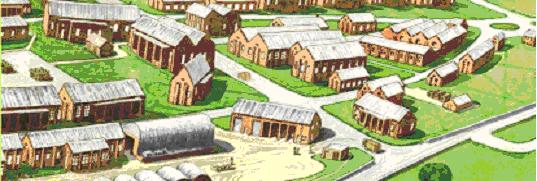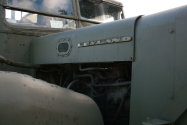|
Dear Ms O'Hara,
I am now 80 years old and was an 18 year old national serviceman
in the winter of 1946/7 at Stainton Camp. As you probably are aware, that was one of the worst winters in living memory, made
worse by a national coal shortage. Most Army units had been sent home on indefinite leave by February '47 as there
was no fuel to keep the sleeping huts warm. Stainton was kept open because we youngsters were being deployed to dig out the
roads and keep the trains moving. There was no fuel anywhere in the camp - except for the cookhouse and the Church Army Hut.
Fire buckets froze solid overnight and our wet denims were stiff with ice in the morning.
I was detailed, just once, to guard the local P.O.W. camp. This
was a four hour night shift and I was unarmed, but issued with a long wooden stick as my symbol of authority. After I had
been left standing, frozen, at the gate for half an hour a German came out of a hut, and sympathising with me, invited
me in to warm up. To my great surprise he had a key to the gate and I gratefully followed him to stand in front of a roasting
stove. The irony was that it was mandatory that the POWs, under the Geneva Convention, be kept warm in captivity. We
squaddies had to tough it out! Like a number of others, I eventually succumbed to the cold and wound up in Catterick
Hospital with pneumonia. The happy ending was to be posted
from the hospital to the RAC Gunnery School at Lulworth Cove in Dorset, to convalesce
through a divine summer by the sea.
Yours,
Ray Smith
click here for more about Blackbeck POW Camp

Dear Eileen
Thanks for your interest and speedy reply. As you seem interested
I will tell you how I got to Catterick Hospital. Because of poor nourishment, no heating, and the freezing temperatures,
lots of troopers became ill. In those days, if one did feel ill, it meant attending a sick parade at 7 a.m. on the Barrack Square. (It was supposed to weed out the malingerers). One was then marched to the M.I. room - an uphill distance
of about a quarter of a mile - and waited for the Medical Officer to arrive. This, I did, and the last thing I can remember
is someone shouting Ambulance!
I woke up in bed in the hospital, warm and cosy, which was one
of the most glorious feelings of my young life...
Out of interest, one of the other N/S youngsters in the camp was
the son of General Montgomery - so the old boy evidently believed in making sure his son suffered along with the plebs.
Of course it's OK to use this material as you think fit
Ray
P.S. I didn't even know until now that the camp where I did guard
duty was Blackbeck!!
|
|

Saturday, December 20, 2008
Dear Eileen
Fascinating stuff and you have my imprimatur. I was interested to see the reference to Broomielaw (did I get the
spelling right?) Station. On Christmas Eve, 1946, a special train was organised to depart from there, taking us soldiers
home on leave. The weather was absolutely atrocious, points were frozen, and at one stage, South of Sheffield, the train
was unable to get up a steep gradient because of ice on the lines and another engine had to be found. My home was
in Bristol. I got as far as Gloucester on Christmas morning, to be told that I could either
walk home the remaining 30 miles to Bristol or catch the next
train, which delivered me to Bristol on Boxing Day!
Two names I remember from those days, both of whose homes were, I think were fairly local, were Sgt Barham, our
squad sergeant, and Corporal Woods, our squad corporal. I wonder if they're still alive. By the way, did anyone ever
dig up any of those tanks that were reputed to have sunk in the moors?
Best wishes
Ray

Our heritage
is who we are today; we are the only ones who can protect it.

The Memories of Stainton Grove Military Camp Project was one of a number of community-led projects along and
nearby the route of the proposed South West Durham Heritage Corridor.
The South West Durham Heritage Corridor will be a multi-user route along the former Bishop Auckland to Barnard Castle railway line.


The Memories of Stainton Grove Military Camp Project is being led by Stainton Grove Community Association and coordinated
by Groundwork West Durham and Darlington. It is funded by the Heritage Lottery Fund through the 'Your Heritage' grant programme.


click to go to warlinks
|
|

